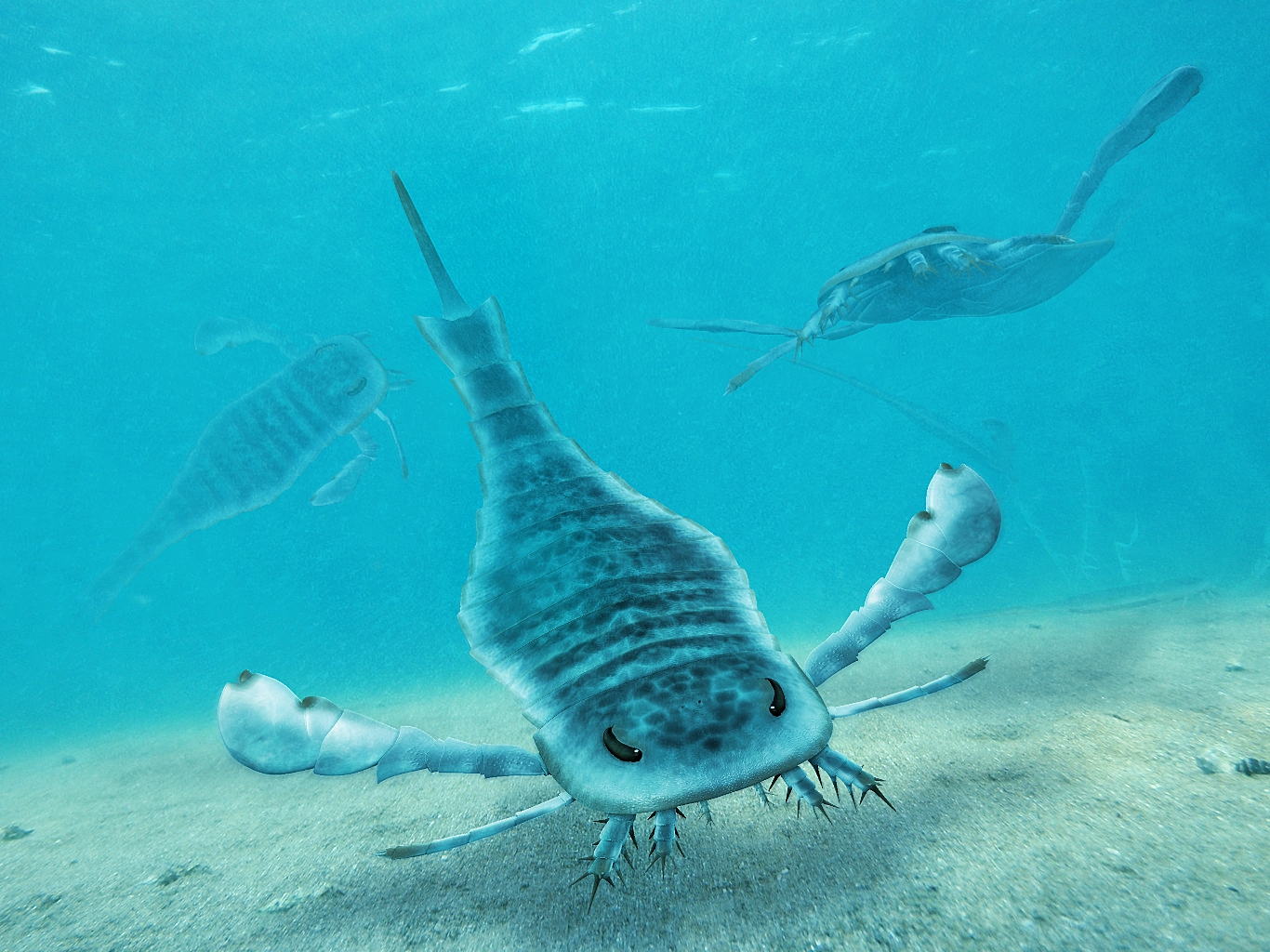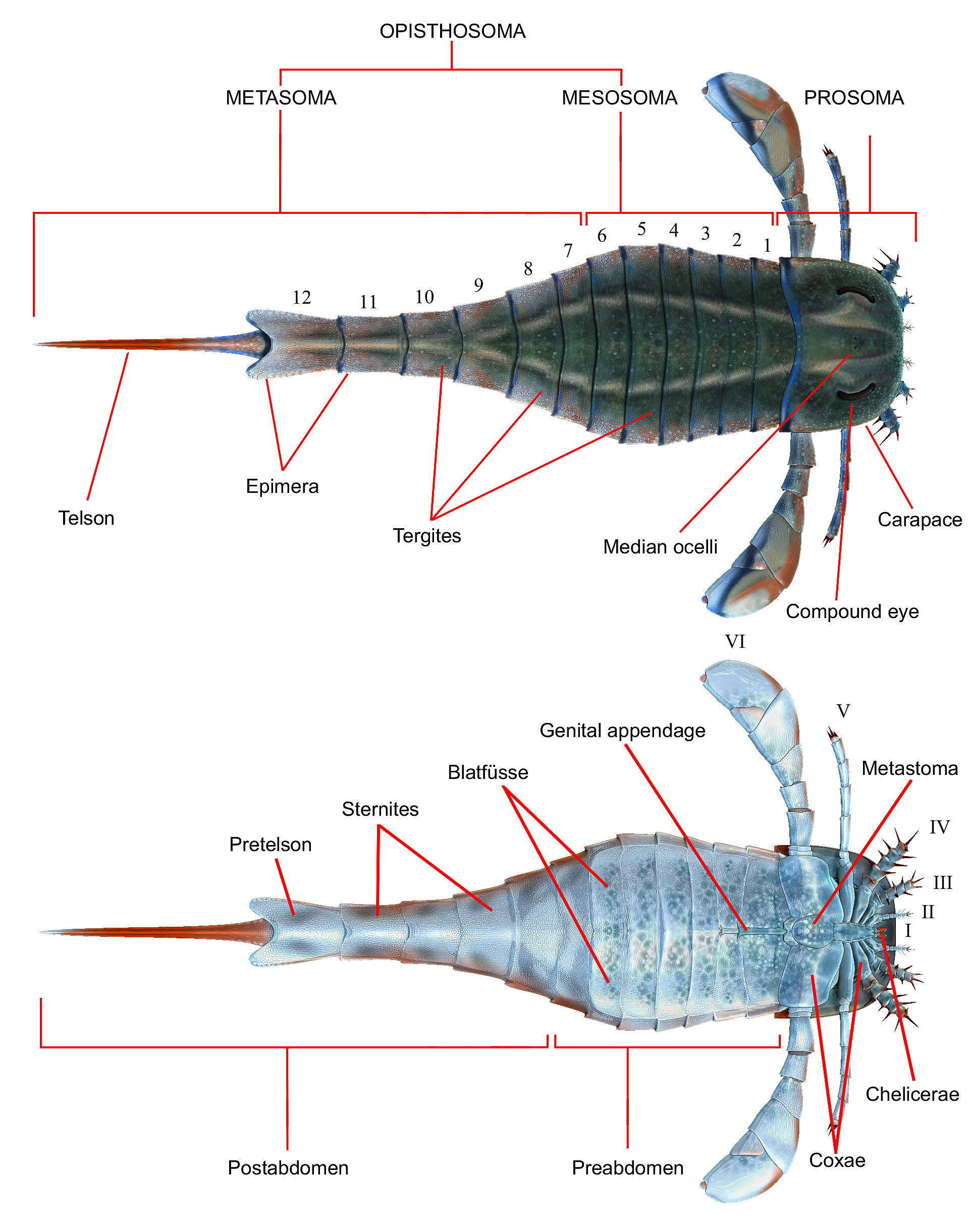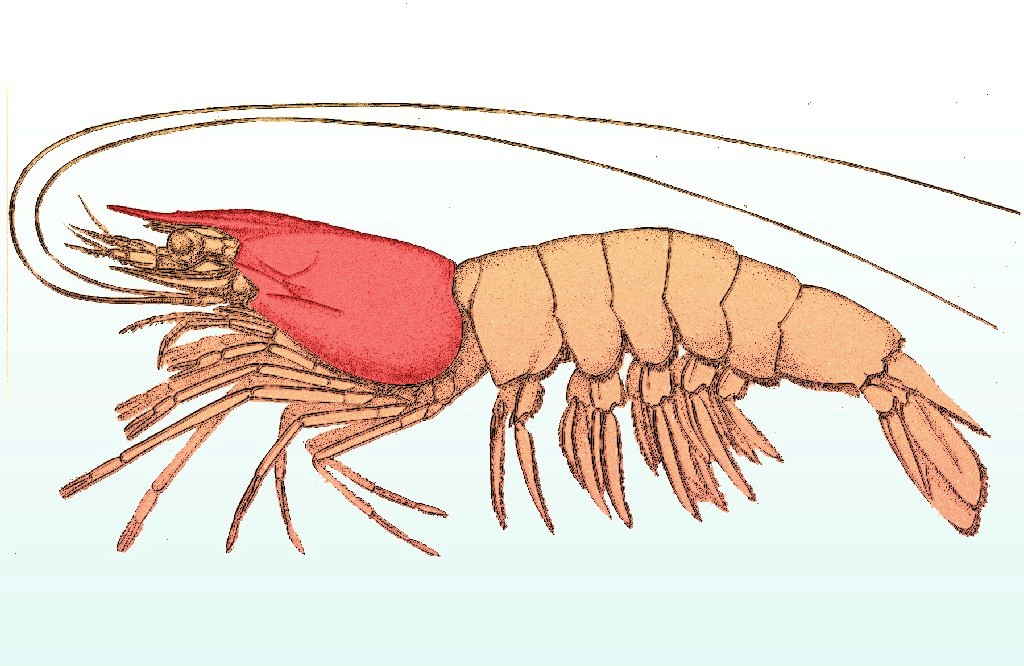|
Strobilopteridae
Strobilopteridae is an extinct family of eurypterids that lived in the Silurian and Devonian periods. The family is one of three families contained in the superfamily Eurypteroidea (along with Dolichopteridae and Eurypteridae), which in turn is one of the superfamilies classified as part of the suborder Eurypterina. The family contains two genera, ''Buffalopterus'' and ''Strobilopterus''. Strobilopterids were eurypterines with semicircular carapaces, a short appendage VI that barely projected from beneath the carapace, ornamentation on the carapace radiating from the lateral eyes and curving around the margins of the carapace and a row of angular scales across the posterior of the tergites on the metasoma. See also * List of eurypterids This list of eurypterid genera is a comprehensive listing of all genera that have ever been included in the order Eurypterida, excluding purely vernacular terms. The list includes all commonly accepted genera, but also genera that are now co ... [...More Info...] [...Related Items...] OR: [Wikipedia] [Google] [Baidu] |
Eurypteroidea
Eurypteroidea are an extinct superfamily of eurypterids. It contains three families (Dolichopteridae, Eurypteridae, Strobilopteridae) and two genera of uncertain classification, ''Paraeurypterus'' and ''Pentlandopterus''. Description Eurypteroidea, which lived from the Ordovician to Devonian periods, were characterized by their last pair of prosomal (head) appendages, which were developed as swimming legs, carrying paddles formed by the expansion of the two penultimate joints. 1955. Merostomata. ''Treatise on Invertebrate Paleontology, Part P Arthropoda 2, Chelicerata'', P30. as Eurypteracea Families *Order Eurypterida Burmeister, 1843 **Suborder Eurypterina Burmeister, 1845 ***Superfamily Eurypteroidea Burmeister, 1845 ****Genus ''Paraeurypterus'' Lamsdell, Hoşgör & Selden, 2013 ****Genus ''Pentlandopterus'' Lamsdell, Hoşgör & Selden, 2013 ****Family Dolichopteridae Dolichopteridae is an extinct family of eurypterids that lived in the Silurian and Devonian periods. De ... [...More Info...] [...Related Items...] OR: [Wikipedia] [Google] [Baidu] |
Strobilopterus
''Strobilopterus'' is a genus of prehistoric eurypterid of the family Strobilopteridae. The genus contains four species, two from the Devonian of Wyoming, United States (''S. princetonii'' and ''S. proteus''), one from the Devonian of Ohio, United States (''S. richardsoni'') and one from the Silurian of Estonia (''S. laticeps'').Dunlop, J. A., Penney, D. & Jekel, D. 2015. A summary list of fossil spiders and their relatives. In World Spider Catalog. Natural History Museum Bern, online at http://wsc.nmbe.ch, version 16.0 http://www.wsc.nmbe.ch/resources/fossils/Fossils16.0.pdf (PDF). Description ''Strobilopterus'' was a large strobilopterid eurypterid, with adults of the species ''S. proteus'' measuring approximately 15 to 20 centimetres in length. The carapace of ''Strobilopterus'' was wide and semicircular in shape, with the lateral eyes lunate to crescentic with the palpebral lobe between the central and centrimesial sectors. The first pair of appendages were small, lacking ... [...More Info...] [...Related Items...] OR: [Wikipedia] [Google] [Baidu] |
Eurypterina
Eurypterina is one of two suborders of eurypterids, an extinct group of chelicerate arthropods commonly known as "sea scorpions". Eurypterine eurypterids are sometimes informally known as "swimming eurypterids". They are known from fossil deposits worldwide, though primarily in North America and Europe. Seventy-five percent of eurypterid species are eurypterines; this represents 99% of specimens. The superfamily Pterygotioidea is the most species-rich clade, with 56 species, followed by the Adelophthalmoidea with 43 species; as sister taxa, they comprise the most derived eurypterines. Pterygotioidea includes the pterygotids, which are the only eurypterids known to have a cosmopolitan distribution. Though more numerous both in specimens and taxa, the eurypterines have the shorter temporal range of the two eurypterid suborders. They first appeared around the same time as the Stylonurina in the Middle Ordovician. The suborder faced a slow extinction during the Middle and Late Devon ... [...More Info...] [...Related Items...] OR: [Wikipedia] [Google] [Baidu] |
Eurypteridae
Eurypteridae is an extinct family of eurypterids that lived in the Silurian and Devonian periods. The family is one of three families contained in the superfamily Eurypteroidea (along with Dolichopteridae and Strobilopteridae), which in turn is one of the superfamilies classified as part of the suborder Eurypterina. The family contains two genera, '' Erieopterus'' and ''Eurypterus''. See also * List of eurypterid genera This list of eurypterid genera is a comprehensive listing of all genera that have ever been included in the order Eurypterida, excluding purely vernacular terms. The list includes all commonly accepted genera, but also genera that are now consider ... * Timeline of eurypterid research References Eurypteroidea Devonian animals Silurian animals Prehistoric arthropod families {{Eurypterid-stub ... [...More Info...] [...Related Items...] OR: [Wikipedia] [Google] [Baidu] |
Eurypterid
Eurypterids, often informally called sea scorpions, are a group of extinct arthropods that form the order Eurypterida. The earliest known eurypterids date to the Darriwilian stage of the Ordovician period 467.3 million years ago. The group is likely to have appeared first either during the Early Ordovician or Late Cambrian period. With approximately 250 species, the Eurypterida is the most diverse Paleozoic chelicerate order. Following their appearance during the Ordovician, eurypterids became major components of marine faunas during the Silurian, from which the majority of eurypterid species have been described. The Silurian genus ''Eurypterus'' accounts for more than 90% of all known eurypterid specimens. Though the group continued to diversify during the subsequent Devonian period, the eurypterids were heavily affected by the Late Devonian extinction event. They declined in numbers and diversity until becoming extinct during the Permian–Triassic extinction event (or sometim ... [...More Info...] [...Related Items...] OR: [Wikipedia] [Google] [Baidu] |
Silurian
The Silurian ( ) is a geologic period and system spanning 24.6 million years from the end of the Ordovician Period, at million years ago (Mya), to the beginning of the Devonian Period, Mya. The Silurian is the shortest period of the Paleozoic Era. As with other geologic periods, the rock beds that define the period's start and end are well identified, but the exact dates are uncertain by a few million years. The base of the Silurian is set at a series of major Ordovician–Silurian extinction events when up to 60% of marine genera were wiped out. One important event in this period was the initial establishment of terrestrial life in what is known as the Silurian-Devonian Terrestrial Revolution: vascular plants emerged from more primitive land plants, dikaryan fungi started expanding and diversifying along with glomeromycotan fungi, and three groups of arthropods ( myriapods, arachnids and hexapods) became fully terrestrialized. A significant evolutionary milestone d ... [...More Info...] [...Related Items...] OR: [Wikipedia] [Google] [Baidu] |
Devonian
The Devonian ( ) is a geologic period and system of the Paleozoic era, spanning 60.3 million years from the end of the Silurian, million years ago (Mya), to the beginning of the Carboniferous, Mya. It is named after Devon, England, where rocks from this period were first studied. The first significant adaptive radiation of life on dry land occurred during the Devonian. Free-sporing vascular plants began to spread across dry land, forming extensive forests which covered the continents. By the middle of the Devonian, several groups of plants had evolved leaves and true roots, and by the end of the period the first seed-bearing plants appeared. The arthropod groups of myriapods, arachnids and hexapods also became well-established early in this period, after starting their expansion to land at least from the Ordovician period. Fish reached substantial diversity during this time, leading the Devonian to often be dubbed the Age of Fishes. The placoderms began domina ... [...More Info...] [...Related Items...] OR: [Wikipedia] [Google] [Baidu] |
Family (biology)
Family ( la, familia, plural ') is one of the eight major hierarchical taxonomic ranks in Linnaean taxonomy. It is classified between order and genus. A family may be divided into subfamilies, which are intermediate ranks between the ranks of family and genus. The official family names are Latin in origin; however, popular names are often used: for example, walnut trees and hickory trees belong to the family Juglandaceae, but that family is commonly referred to as the "walnut family". What belongs to a family—or if a described family should be recognized at all—are proposed and determined by practicing taxonomists. There are no hard rules for describing or recognizing a family, but in plants, they can be characterized on the basis of both vegetative and reproductive features of plant species. Taxonomists often take different positions about descriptions, and there may be no broad consensus across the scientific community for some time. The publishing of new data and opi ... [...More Info...] [...Related Items...] OR: [Wikipedia] [Google] [Baidu] |
Dolichopteridae
Dolichopteridae is an extinct family of eurypterids that lived in the Silurian and Devonian periods. Description Dolichopterid eurypterids had outer surfaces that were either smooth or with pustules and semilunar scales. The compound eyes were arcuate and located anteriorly on the prosoma (head). The abdomens had epimers (lateral projections). The telson (the posteriormost division of the body) was lanceolate. The chelicerae were small, and the first three pairs of walking legs were stout, with powerful spines. The last pair of walking legs had supplementary lobes, while the swimming legs had the last joint enlarged, as part of the paddle. The male genital appendage was long. 1955. Merostomata. ''Treatise on Invertebrate Paleontology, Part P Arthropoda 2, Chelicerata'', P39. See also * List of eurypterids This list of eurypterid genera is a comprehensive listing of all genera that have ever been included in the order Eurypterida, excluding purely vernacular terms. The list i ... [...More Info...] [...Related Items...] OR: [Wikipedia] [Google] [Baidu] |
Genus
Genus ( plural genera ) is a taxonomic rank used in the biological classification of living and fossil organisms as well as viruses. In the hierarchy of biological classification, genus comes above species and below family. In binomial nomenclature, the genus name forms the first part of the binomial species name for each species within the genus. :E.g. '' Panthera leo'' (lion) and '' Panthera onca'' (jaguar) are two species within the genus ''Panthera''. ''Panthera'' is a genus within the family Felidae. The composition of a genus is determined by taxonomists. The standards for genus classification are not strictly codified, so different authorities often produce different classifications for genera. There are some general practices used, however, including the idea that a newly defined genus should fulfill these three criteria to be descriptively useful: # monophyly – all descendants of an ancestral taxon are grouped together (i.e. phylogenetic analysis should c ... [...More Info...] [...Related Items...] OR: [Wikipedia] [Google] [Baidu] |
Buffalopterus
''Buffalopterus'' is a prehistoric eurypterid from the Silurian-aged Bertie Formation of New York and Ontario. The genus contains one species, ''B. pustulosus''. It is closely related to ''Strobilopterus'', but differs primarily by having a bizarre, globular telson (which is otherwise sword-like or spine-like in other eurypterids), and in size, being estimated to be at least 1 meter in length.Some Eurypterida from the Ordovician and Silurian of New York Erik N. Kjellesvig-Waering and Carol A. Heubusch See also * List of eurypterids This list of eurypterid genera is a comprehensive listing of all genera that have ever been included in the order Eurypterida, excluding purely vernacular terms. The list includes all commonly accepted genera, but also genera that are now conside ... References Eurypteroidea Silurian eurypterids Eurypterids of North America Fossils of Canada Paleontology in Ontario Bertie Formation Fossil taxa described in 1962 {{eurypterid-stub ... [...More Info...] [...Related Items...] OR: [Wikipedia] [Google] [Baidu] |
Carapace
A carapace is a dorsal (upper) section of the exoskeleton or shell in a number of animal groups, including arthropods, such as crustaceans and arachnids, as well as vertebrates, such as turtles and tortoises. In turtles and tortoises, the underside is called the plastron. Crustaceans In crustaceans, the carapace functions as a protective cover over the cephalothorax (i.e., the fused head and thorax, as distinct from the abdomen behind). Where it projects forward beyond the eyes, this projection is called a rostrum. The carapace is calcified to varying degrees in different crustaceans. Zooplankton within the phylum Crustacea also have a carapace. These include Cladocera, ostracods, and isopods, but isopods only have a developed "cephalic shield" carapace covering the head. Arachnids In arachnids, the carapace is formed by the fusion of prosomal tergites into a single plate which carries the eyes, ocularium, ozopores (a pair of openings of the scent gland of Opilione ... [...More Info...] [...Related Items...] OR: [Wikipedia] [Google] [Baidu] |





